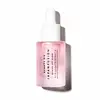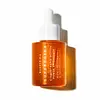What's inside
What's inside
 Key Ingredients
Key Ingredients

 Benefits
Benefits

 Concerns
Concerns

 Ingredients Side-by-side
Ingredients Side-by-side

Water
Skin ConditioningGlycerin
HumectantButylene Glycol
HumectantTripropylene Glycol
AntioxidantDiglycerin
HumectantMethyl Gluceth-10
EmulsifyingPhenoxyethanol
PreservativePolysorbate 20
EmulsifyingPEG-40 Hydrogenated Castor Oil
EmulsifyingPentylene Glycol
Skin ConditioningXanthan Gum
EmulsifyingCitrus Jabara Peel Extract
Skin ConditioningSodium Citrate
BufferingCladosiphon Novae-Caledoniae Polysaccharide
HumectantHydrolyzed Vitis Labrusca Skin Extract
EmollientParfum
MaskingCitric Acid
BufferingPentasodium Pentetate
Schizosaccharomyces Pombe Extract
Skin ConditioningWater, Glycerin, Butylene Glycol, Tripropylene Glycol, Diglycerin, Methyl Gluceth-10, Phenoxyethanol, Polysorbate 20, PEG-40 Hydrogenated Castor Oil, Pentylene Glycol, Xanthan Gum, Citrus Jabara Peel Extract, Sodium Citrate, Cladosiphon Novae-Caledoniae Polysaccharide, Hydrolyzed Vitis Labrusca Skin Extract, Parfum, Citric Acid, Pentasodium Pentetate, Schizosaccharomyces Pombe Extract
Ingredients Explained
These ingredients are found in both products.
Ingredients higher up in an ingredient list are typically present in a larger amount.
Butylene Glycol (or BG) is used within cosmetic products for a few different reasons:
Overall, Butylene Glycol is a safe and well-rounded ingredient that works well with other ingredients.
Though this ingredient works well with most skin types, some people with sensitive skin may experience a reaction such as allergic rashes, closed comedones, or itchiness.
Learn more about Butylene GlycolCitric Acid is an alpha hydroxy acid (AHA) naturally found in citrus fruits like oranges, lemons, and limes.
Like other AHAs, citric acid can exfoliate skin by breaking down the bonds that hold dead skin cells together. This helps reveal smoother and brighter skin underneath.
However, this exfoliating effect only happens at high concentrations (20%) which can be hard to find in cosmetic products.
Due to this, citric acid is usually included in small amounts as a pH adjuster. This helps keep products slightly more acidic and compatible with skin's natural pH.
In skincare formulas, citric acid can:
While it can provide some skin benefits, research shows lactic acid and glycolic acid are generally more effective and less irritating exfoliants.
Most citric acid used in skincare today is made by fermenting sugars (usually from molasses). This synthetic version is identical to the natural citrus form but easier to stabilize and use in formulations.
Read more about some other popular AHA's here:
Learn more about Citric AcidPentylene glycol is typically used within a product to thicken it. It also adds a smooth, soft, and moisturizing feel to the product. It is naturally found in plants such as sugar beets.
The hydrophilic trait of Pentylene Glycol makes it a humectant. As a humectant, Pentylene Glycol helps draw moisture from the air to your skin. This can help keep your skin hydrated.
This property also makes Pentylene Glycol a great texture enhancer. It can also help thicken or stabilize a product.
Pentylene Glycol also acts as a mild preservative and helps to keep a product microbe-free.
Some people may experience mild eye and skin irritation from Pentylene Glycol. We always recommend speaking with a professional about using this ingredient in your routine.
Pentylene Glycol has a low molecular weight and is part of the 1,2-glycol family.
Learn more about Pentylene GlycolWater. It's the most common cosmetic ingredient of all. You'll usually see it at the top of ingredient lists, meaning that it makes up the largest part of the product.
So why is it so popular? Water most often acts as a solvent - this means that it helps dissolve other ingredients into the formulation.
You'll also recognize water as that liquid we all need to stay alive. If you see this, drink a glass of water. Stay hydrated!
Learn more about Water